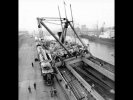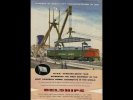The
Six Cab Units: Before SP 9010
by Robert J. Zenk
by Robert J. Zenk
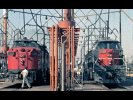 August 1964
SP9000 and SP9010 Richard Oed Photo |
Call them 'Prototypes'.
We should start by getting our terms straight: all Krauss-Maffei ML4000C'C' locomotives were not created equal.
The first six 'Cab Units' built in 1961 share both the basic mechanical layout and the identical model number with our SP 9010 of 1964. But the differences are obvious. Why did K-M not differentiate?
Apparently they did. The first six ML4000's of 1961 were referred to by K-M as "Prototypen", while the 15 units delivered in 1964 were called "Serien", or 'Series'. And in fact, they were part of a series. No further units of the 1961 style were built, but 16 more copies of the "Serienloks" were built through 1969. (See "The Boys From Brazil")
American railfans and railroaders have always used the terms "Cab Unit" and "Hood Unit" to differentiate between ML4000's. These terms get confusing when the conversation goes international -- since the "Cabs" had 'hoods', and the "Hoods" had 'cabs'! European and American fans sometimes scratch their heads.
So we'll use the terms that K-M used. Here's a brief history of the six 'Prototypes'...
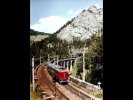 Semmering, Austria
1961 Krauss-Maffei A.G. |
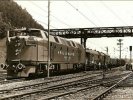 Krauss-Maffei Werkfoto
|
SP 9000-9002
Tested extensively and successfully on the rigorous Semmering grade in Austria, the first SP Krauss-Maffeis were offloaded at the Port of Houston in October of 1961. Industry and fan publications alike had been buzzing about the debut for months.
The units came West, and took up residence in Roseville, California - where German technicians joined them, training the SP maintenance forces in the intricacies of high-revving turbo V-16's and torque converter transmissions. Metric tools were spoken here, as well as German!
Origins
In 1960, Southern Pacific had retired the last of its steam locomotives, and its Diesel fleet was beginning to show its age. Multiple-unit locomotive lashups were growing as train tonnage grew, and the electrical 'transmissions' (generators and axle-mounted traction motors) were causing cost and maintenance issues.
SP wanted higher horsepower and better tractive effort. But the domestic locomotive builders were conservative, and preferred to sell from their existing catalogs. Horsepower was creeping upwards, from a nominal 1500HP per unit to a new threshold of 2400HP - but these more powerful units were, at the time, either experimental or not completely successful.
In Europe, Krauss-Maffei was building 3000HP locomotives with direct-geared hydraulic transmissions, delivering 33% adhesion factors -- at a standstill -- without traction motors to overheat. SP took notice.
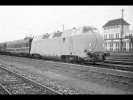 Richard Oed Photo
|
The late 1950's were a cost-cutting time for the SP. So it's curious that anyone at 65 Market Street 'HQ' would have considered importing expensive German locomotives in order to economize. But SP Chairman D.J. Russell was notorious for asking his employees to use 'fourth-dimensional thinking', and initial cost was not perhaps as significant to SP as the potential for downstream savings.
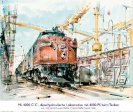 Drawing - Aquarell
Collection of Richard G. Oed |
Design.
The units were built to AAR buffing standards and plate clearances, with the exception of the most notable (and controversial) feature - the 'tumblehome' turret-style cab with slanted windows. This was a mandate for travel between the factory at München-Allach and the port of embarkation. Even under those constricted clearances, these locomotives dwarfed all European power of the day, and most American diesels as well!
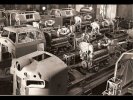 Krauss-Maffei A.G. Photo
|
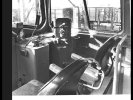 Robert J. Zenk Collection
|
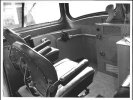 Robert J. Zenk Collection
|
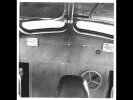 Robert J. Zenk Collection
|
Another curious consideration was the enclosed carbody styling - some saw it as a cross between an ALCo PA and an EMD E-unit. SP had rejected a proposed centercab design similar to the ML2700 K-M had built for Turkey. (See "Cousins")
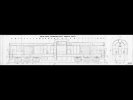 Krauss-Maffei
Collection of Richard G. Oed |
K-M responded with a portholed giant. By 1961, enclosed carbody locomotives - a relic of the Streamline Age -- were almost out of favor in the U.S. But after rejecting a first proposal, SP signed off on the final design.
We don't know why, but the explanation may have to do with a desire for crews to be able to monitor the unfamiliar mechanicals from a weatherproof vantage point.
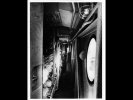 Robert J. Zenk Collection
|
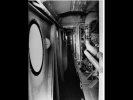 Robert J. Zenk Collection
|
Or it may simply have been K-M's attempt to be responsive to the SP's desire for the units to look more 'American' - but as Germans in 1961 would have interpreted the concept.
 Krauss-Maffei A.G. Photo
|
Construction.
The girder frames were built to withstand a one-million-pound buffing force, well in excess of European standards of the time. AAR couplers and Wabco 26L brake gear were standard-issue, and were 'reverse-imported'.
One distinct variation between the K-M carbody and U.S. units of similar appearance: the K-M featured separate removable hood sections --including the cab, which sat on rubber cones, double-walled and heavily insulated with Stonewool. All hood sections were rubber-gasketed, and the units were regarded by operators as "almost too quiet."
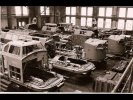 Krauss-Maffei A.G. Photo
|
Troubles.
Almost immediately, problems arose with the highly-stressed Maybach MD870 V-16's. A marvel of German craftsmanship, they were analogous to automobile engines of the same period: where American motors used lots of cubic inches and moderate RPM's to create gobs of torque and horsepower, Germans used multiple valves, overhead camshafts, roller bearing cranks, multiple turbocharging, and high RPM's to deliver horsepower with high efficiency from compact size.
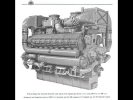 Maybach Motorenbau
|
The cost was in rigorous maintenance requirements, and the fact that K-M and Maybach had seriously upped the ante in boosting output to 2000HP per motor without having been able to first test the product under U.S. conditions.
There was no place in Germany where locomotives could run in the last throttle notch for hours on end, climb mile-high grades in snowfall at a crawling pace, while beginning and ending their runs in 100-degree-plus heat. The first few months of Prototype operations in the U.S. were a true shakedown and 'proof of concept.'
And the concept had flaws.
Modifications.
Soon, the Prototypes sported 'chimneys' grafted onto the carbody sides. A distant precursor to EMD's "tunnel motors", this was a means to keep the hot air from radiators and exhaust from contaminating the intake air.
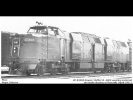 Strapac Collection
Division Point Models |
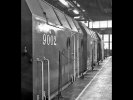 Roseville, Ca.
Robert Morris |
During the first few trips in close-clearance tunnels, the units were 'short-cycling' their intake air and catastrophically frying their valve trains - and there were six valves per cylinder, ninety-six per motor, one-hundred-ninety-two per locomotive, five-hundred-seventy-six valves for the three-unit lashup!
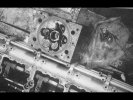 Lok Magazin Collection
|
The 'chimneys' worked, and soon the Mechanical Department devised internal ducting which did the same thing. At that time, air reservoirs and aftercooler piping were moved to the roof, and other internal equipment was rearranged for ease of maintenance. The original multiple-unit controls were pneumatic, and these complicated systems were soon replaced so that the K-M's could operate with any U.S. locomotive.
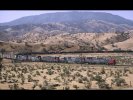 Caliente, Ca.
May 21, 1966 Tom Gildersleeve Photo |
Operations settled down, and in October of 1962 were apparently satisfactory enough that the order was placed for 15 "Series" locomotives to follow, as further proof-of-concept, but this time in fleet-sized deployment. Our SP 9010 was in that order.
The Prototype units were pulling their weight. And pull they could: the San Joaquin Division Special Instructions for April 26, 1964 show the class as rated for 7625 tons on the drawbar between Tracy and Fresno, California. Their stalwart GP-9 fleetmates were rated at a comparatively slight 3950, and even the ALCo DL-600B 'Alligators' - failed contemporaries in the new Horsepower Wars -- were rated at a still-distant 5900 tons.
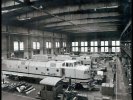 Krauss-Maffei A.G. Photo
|
D&RGW 4001-4003.
There were six Prototypes built in 1961. Denver & Rio Grande Western was an investment and operational partner with the Southern Pacific, and split the SP's order with three Prototypes of their own.
The Rio Grande's experience mirrored the SP's, and they also moved air reservoirs and internal equipment, and grafted 'chimneys' which were later replaced by internal ducting.
Rio Grande also loaned out their units - one went West to test out four-unit K-M lashups on the SP, while two went East - only to stumble badly in the middle of a frigid winter on the D&H and NYC. Ultimately the Rio Grande decided to end their experiment and sell their three K-M's to the SP.
This happened not entirely coincidentally in the same month that SP 9010 was nearing completion on the K-M factory floor. Maybe enthusiasm was still high. Or maybe it was a case of "in for a penny, in for a pound."
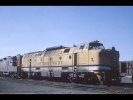 Mike Myers Collection
|
SP 9021-9023.
Operating at first in "Grande Gold" with black SP lettering, the three 'Moffat' K-M's came West, added to SP's roster on February 6, 1964. Soon, there were 21 diesel-hydraulic locomotives in operation on the SP, including three built in the U.S. by ALCo.
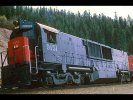 PLA Excursion
May 30, 1968 Robert J. Zenk Photo |
 PLA Excursion
May 30, 1968 Robert J. Zenk Photo |
The former Grande units were repainted in a subtle variation on the factory's SP masking scheme, which soon made its way to the SP's original units when their German enamel fell victim to harsh California sun and harsher washing chemicals.
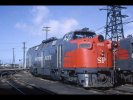 Alan Miller Photo
Mike Myers Collection |
Sometimes paired with the 1964 'Series' units, but more often in multiple with a domestic F-7 or GP-9, the six Prototypes soldiered on until 1967, when the first retirements began. They were the first K-M's to feel the scrapper's torch as well, once the SP decided not to renew or sustain the Great Hydraulic Experiment. One by one as road failures occurred, the units were taken out of service and retired.
None were preserved.
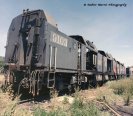 Sacramento, Ca.
Bob Morris Photo |
Cab-Unit
Roster
Southern Pacific 9000
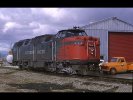 Tracy, Ca.
Tom Gildersleeve Photo |
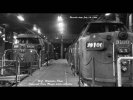 Roseville, Ca.
July 14, 1966 Will Whitaker Photo Dave Maffei Collection |
C/N 18694, SP Order P-1072, K-M Order 144033/2
Built June 1961 as class DF-800
Renumbered October 1965 to SP 9100, class KF-636A-1
Retired 4-1-68
Southern Pacific 9001
 SP 9001 with SP9010
R.D. McDonald Photo |
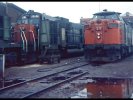 SP 9101
Jim Evans Photo |
C/N 18695, SP Order P-1072, K-M Order 144033/2
Built June 1961 as class DF-800
Renumbered October 1965 to SP 9101, class KF-636A-1
Retired 6-21-68
Southern Pacific 9002
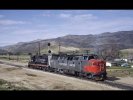 Bealville, Ca.
February 22, 1966 Tom Gildersleeve Photo |
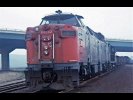 SP 9102
Jim Evans Photo |
C/N 18696, SP Order P-1072, K-M Order 144033/2
Built June 1961 as class DF-800
Renumbered October 1965 to SP 9102, class KF-636A-1
Retired 9-1-67
Denver & Rio Grande
Western 4001
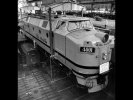 Krauss-Maffei A.G. Photo
|
C/N 18697, K-M Order 144036/2
Built June 1961
Purchased by SP 2-6-64, renumbered to SP 9021
Renumbered October 1965 to SP 9103, class KF-636A-2
Retired 9-1-67
Denver & Rio Grande Western
4002
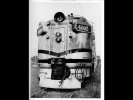 Krauss-Maffei A.G. Photo
|
C/N 18698, K-M Order 144036/2
Built June 1961
Purchased by SP 2-6-64, renumbered to SP 9022
Renumbered October 1965 to SP 9104, class KF-636A-2
Retired 9-1-67
Denver & Rio Grande
Western 4003
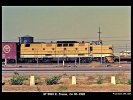 East
Fresno, Ca.
February, 1965 Don Bowen |
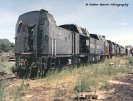 Sacramento, Ca.
Bob Morris Photo |
C/N 18697, K-M Order 144036/2
Built June 1961
Purchased by SP 2-6-64, renumbered to SP 9023
Renumbered October 1965 to SP 9105, class KF-636A-2
Retired 9-1-67
Further reading.
This page offers only a gross overview of the six predecessors of PLA's SP 9010. Excellent detailed examination of these units can be found in what we like to call 'The K-M Bible' - Joseph A. Strapac's "Southern Pacific Historic Diesels, Volume 2" published in 1993 and doing very well on eBay these days.
Joe also authored the first extensive historical reference on the SP's K-M experiment, found in his "Southern Pacific Motive Power Annual 1968-1969." Both are invaluable references for the K-M enthusiast.
Another excellent and more recent source is the Fall 2005 issue of "SP Trainline", published by the Southern Pacific Historical & Technical Society. This eight-page-plus-color-cover article ("A Krauss-Maffei Postscript") features a wealth of newly-minted operational and mechanical data.
That article also quotes generously from another reference rich with factory photographs and data: "The Krauss-Maffei ML4000C'C'" is a 12-page article from the October, 1984 issue of "Mainline Modeler" magazine, copies of which can also be found for sale online.
European readers can look for "Lok Magazin" issue 164, from Sep/Oct 1990, an excellent overview with many photos unseen by American railfans. Haunting the reference section of large libraries for "Railway Age" and other industry periodicals is always entertaining. And finally, there are several fine articles in "Trains" magazine, dating from before the K-Ms arrived on U.S. soil, right to the end of their saga.
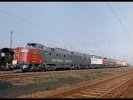 Krauss-Maffei A.G. Photo
Richard G. Oed Collection |
